Octad
Element
Two tetrads of Active elements and Structural elements
Active Elements:
- Summit
- Atom
- Base
- Totality
Structural Elements:
- States
- Functions
- Necessities
- Ideals
The symbol used to represent this system is derived from South-West Asia, where it is a common means of expressing a total order in which all things find their place. When all the first order connectivities are drawn, we have the total octad symbol, which has proved an invaluable heuristic tool in educational research done by the Institute.
The common region of the two squares is called the Arena and is considered to represent the region within which the action of harmonization of conflicting demands takes place
In the square of structural elements 1-3-5-7, the horizontal line 3-7 represents the range from the atomic to the total aspects of the structure. The vertical line 1-5 represents the scale of influences from the most spiritual to the most material. Each of these lines has seven nodes in the total octad symbol, which can be characterized for each situation studied as a totality.
The square 2-4-6-8 represents the conditions required for the completed action to take place.
In the octad of a human life, the arena designates the region of action that is the total content of the active adult life. The arena, in general, is the region of sway of the particular will by which the situation is determined. This will need not be personal; it may be social, as for example, the will of society to educate its young.
The octad affords a means for a total grasp of a situation. To illustrate by education. Education is a link between successive generations of mankind. It involves intricate personal relationships but is important for the entire human race. Influences which bear upon it range from the highest of human spirituality to the basic vital processes of the organism. Education must adapt to the changing needs and advancing ideals of humanity. All this can be represented by means of the octad with a minimum of explanation.
At the centre is the school or college, which is the point of effective action in the harmonization of the totality. To the left, is involvement in the total society; to the right, concern with the group and individual. Consideration of all the points of intersection of the total octad symbol then becomes the basis for an adequate study of the 'educational situation'. It is with regard to such structures as education, organized in depth, that the octad proves of greatest value.
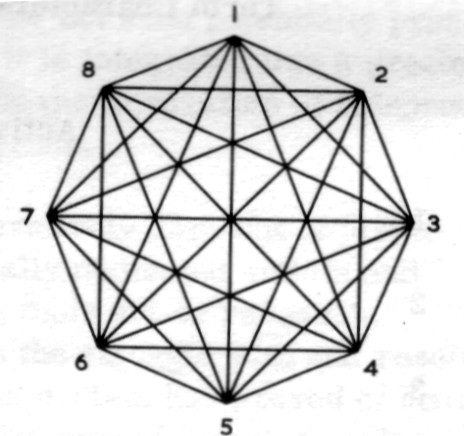
References for the Octad:
-
Asian
- Eight Auspicious Symbols – Tibetan
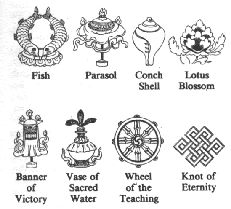
-
-
Eight Kerima Dakinis – Tibetan
-
Dakinis of the eight kinds of awareness. According to the Bardo Thödol, these deities appear on the 12th day of the bardo, surrounding the Krodeshvari-Heruka couples. They are subdivided into two groups:
- Four Inner Dakinis (Nang-gi mkha'-'gro bzhi) of the cardinal directions (pure colors)
- Four Outer Dakinis (Phyi-yi mkha'-'gro bzhi) of the intermediate directions (mixed colors)
-
Together, they represent the fierce, terrifying female counterparts of the eight male Bodhisattvas.
- East: white skinned Kerima (or Gauri) carrying a kapala (skull cup) and a club in the form of a human corpse
- SE: orange skinned Pukkasi carrying entrails (Tib., ??)
- South: yellow skinned Caurima (Chauri) carrying a drawn bow and arrow
- SW: green-black skinned Ghasmari carrying a dorje and drinking blood from an asrikkapala
- West: red skinned Pramoha carrying the banner of victory
- NW: yellow-white skinned Candali carrying a corpse and a heart
- North: green skinned Vetali (Vaitali, Petali) carrying a kapala and a dorje
- NE: blue-black skinned Smashali (Smasani) twisting the head off a corpse
-
Dakinis of the eight kinds of awareness. According to the Bardo Thödol, these deities appear on the 12th day of the bardo, surrounding the Krodeshvari-Heruka couples. They are subdivided into two groups:
- Kalachakra Mandala – Tibetan
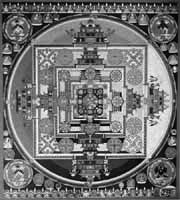
-
Eight Chinese Immortals
- The Eight Immortals crossing the sea, from Myths and Legends of China, 1922 by E. T. C. Werner. Clockwise in the boat starting from the stern: He Xiangu, Han Xiang Zi, Lan Caihe, Li Tieguai, Lü Dongbin, Zhongli Quan, Cao Guojiu and outside the boat is Zhang Guo Lao
- The Eight Immortals (八仙 in pinyin: bā xiān; in Wade-Giles: pa hsien) are Chinese deities who are represented as a group and rarely individually. Each Immortal's power can be transferred to a tool of power (法器) that can give life or destroy evil. Together, these eight tools are called "Covert Eight Immortals" (暗八仙 àn ~). Most of them are said to have been born in Tang Dynasty or Song Dynasty. Not only are they worshipped by the Daoists, but they are a popular element in the secular Chinese culture. They live on Penglai Mountain-Island.
-
The Immortals are:
- Immortal Woman He (He Xiangu),
- Royal Uncle Cao (Cao Guojiu),
- Iron-crutch Li (Li Tieguai),
- Lan Caihe,
- Lü Dongbin,
- Philosopher Han Xiang (Han Xiang Zi),
- Elder Zhang Guo (Zhang Guo Lao), and
- Zhongli Quan.
- In literature before the 1970s, they were sometimes translated as the Eight Genii. First described in the Yuan Dynasty, they were probably named after the Eight Immortal Scholars of the Han.
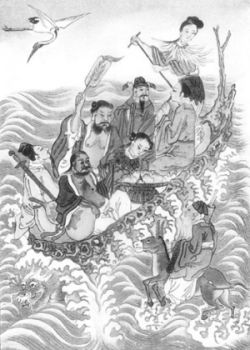
- Right View - Wisdom
- Right Intention
- Right Speech - Ethical Conduct
- Right Action
- Right Livelihood
- Right Effort - Mental Development
- Right Mindfulness
- Right Concentration
-
Eight Kerima Dakinis – Tibetan
-
Early & Sufi
- Ogdoad - Egyptian
- Ogdoad - Gnostic
- Symbolism of eight-fold rosettes
-
Cultural References – Eight
- Spiritually eight is the goal of the initiate, having gone through the seven stages. Eight is Infinity - Paradise regained.
- Eight is solidarity as the first cube and it denotes perfection by virtue of it's six surfaces. There are eight winds and intermediate directions of space. Eight represents the pairs of opposites. The octagon is the beginning of the transformation of the square into a circle and vice versa.
-
Eight in many cultures and ideologies seems to have similar meanings:
- Felicity
- Perfect rhythm
- Regeneration
- Resurrection
- In some myths the eighth day created the new "man" of grace. After seven days of fasting and penance the eighth day becomes plenty and renewal. 7+1 is the number of the octave which is a continual theme in all esoteric belief systems. The knowledge of frequency and sound are a vital key in the ancient "mystery schools".
- Buddhist tradition: eight is completion, all possibilities. There are eight symbols of good augury.
- Chinese system of belief eight represents the whole. It is all possibilities in manifestation. Eight is seen as a good luck number. The PAKUA is the design depicting the eight trigrams and pairs of opposites, usually in a circle, the circumference of which symbolizes time and space. There are eight delights of human existence.
- Christian: Eight is regeneration and rebirth. The font is usually octagonal as symbolizing the place of regeneration. There are eight beatitudes.
- Egyptian: Eight is the number of Thoth.
- Hebrew: Eight is perfect intelligence; splendor. The digit value of "IHVH" is the "Number of the Lord". The Temple was sanctified in eight days.
- Hermetic: In their system there is one chief God, (eight minor gods) Thoth/Hermes was the inventor of numbers and geometry.
- Hindu: 8x8 symbolism is the order of the celestial world established on earth. Temples are built on the pattern of the MANDALA, which is the 8x8 symbol. In their belief system there are eight regions of the world, suns, divisions of the day, and eight chakras.
- Islamic: The throne which encompasses the world is supported by eight angels, corresponding to both the eight divisions of space and the groups of letters in the Arabic alphabet.
- Japanese: Eight is the "many". There are eight Gods in the heavens.
- Platonic: Plato has eight spheres of different colors surrounding the luminous pillars of the heavens.
- Pythagorean: Eight is solidarity and stability.
- Sumero-Semitic: Eight is the magic number of Nebo.
- Taoist: Eight to be All possibilities in manifestation with the Pa Kua representing the forces in the phenomenal world. There are eight Taoist genii or immortals.
-
Eight Principles of Khwaja Abd al-Khaliq al-Ghujdawani – Sufi
-
Yad Kard
- Remembrance, or making mention. Both oral and mental. Be always repeating the Dhikr imparted to you so that you may attain the beatific vision. Khwaja Bahauddin Naqshband said, "The aim in Dhikr is that the heart be always aware of al-Haqq [The Truth, a Beautiful Name of Allah], for its practice banished inattention."
-
Baz Gasht
- Restraint. The person saying the Dhikr, when engaging in the heart-repetition of the blessed phrase [shahada] should intersperse it with such phrases as "my God you are my Goal and your satisfaction is my aim", to help to keep one's thoughts form straying. Other masters say that it means 'return' or 'repent', i.e, return to al-Haqq by way of contrition [inkisar].
-
Nigah Dasht
- Watchfulness. Over wandering, passing thoughts when repeating the blessed phrase.
-
Yad Dasht
- Recollection. Concentration upon the Divine Presence in a condition of Dhawq [zoq], foretaste, intuitive anticipation or perceptiveness, not using external aids.
-
Hosh dar dam
- Awareness while breathing. The technique of breath control. Said Khwaja Bahauddin Naqshband, "The external basis of this tariqa is the breath." One must not exhale in forgetfulness or inhale in forgetfulness.
-
Safar dar watan
- Journeying in one's homeland. This is an interior journey, the movement from blameworthy to praiseworthy qualities. Others refer to it as the vision or revelation of the hidden side of the Shahada.
-
Nazar bar qadam
- Watching one's steps. Let the salik [pilgrim] ever be watchful during his journey, whatever the type of country through which he is passing that he does not let his gaze be distracted from the goal of his journey.
-
Khalwat dar anjuman
- Solitude in a crowd. The journey of the salik, though outwardly it is in the world, inwardly it is with God. Leaders of the Tariqa have said,"In this tariqa association is in the crowd [assembly] and disassociation in the khalwa." A common weekly practice was to perform the dhikr in the assembly.
- http://www.uga.edu/islam/11Naqsprin.html
-
Yad Kard
- Symbolism
- Time Cycles and Divination
-
Occult
-
Chessboard
- And it is not just occultists, but nature herself who arranges the elements of the universe into patterns of 8 x 8. Everyone who has ever taken a music class is familiar with how the rule of eight plays into harmonics, and how each eighth note in the musical scale is the same as the one seven notes previous, only at a higher vibration (one octave.) The same principle holds true on the Periodic Table of Elements, where each eighth element shares the properties of the one seven atomic numbers lower on the chart. (Also, all of the elements within that string of eight have common properties.) Even the elements of our DNA are made this way. DNA is made up of six-part “codons” consisting of six letters that each represent a protein, and of course, there are 64 possible combinations of them. The adaptability of the chessboard to systems such as this demonstrates how chess still lends itself to the task of divination.
- That the chessboard is a beautifully complex matrix of interacting elements has not escaped the notice of mathematicians throughout the centuries. Scores of books have been written about the numerous “magic squares” that can be created on an 8 x 8 chessboard. Magic squares are matrices filled with numbers, in which all of the rows and columns add up to the same sum. They can also be made out of the letters of any alphabet, or in fact any set of symbols that one would want to use. People have discovered thousands of magic squares that can be placed on the chessboard, creating all sort of amazing numerical patterns, which can then be transformed into colors, pictures, or musical notes. You can even make magic squares on the chessboard using the I-Ching hexagrams, the geomancy patterns, the 32 Hebrew “paths”, and the DNA codons. Magic squares are considered genuinely magical in the occult, believed to represent planetary intelligences, and were thought to bring wealth or cure diseases in medieval times. For instance, many occult novices are familiar with the so-called “Templar magic square”, which is actually as old as civilization. Interestingly, the magic square attributed to the intelligence of Mercury is an 8 x 8 matrix.
- But by far the most famous 8 x 8 magical squares are those associated with the Knight’s Tour. This is the name of a puzzle of interest to both chess players and mathematicians alike. The aim is for the knight to visit each and every square on the chessboard once, and only once, using the L-shaped knight’s move. There are thousands of solutions on the 8 x 8 chessboard. Knight’s Tours can also be displayed on a number of other platforms, including larger or smaller boards, and even three-dimensional objects like cubes, tubes, and cylinders. (There are tours for rooks and kings as well, yielding different results.) They are classified as either “open” or “re-entrant”, depending on whether or not the knight ends up on the same square from which it started. (The re-entrant tours are considered the most “elegant.”) Numerous magic squares (as well as cubes and cylinders) can be created by numbering the squares that the knight visits in chronological order to create an array. Drawing lines to connect these squares in order can create beautiful web-like patterns. One, discovered by Edward Falkber, yields a pattern at its center resembling a stylized swastika. And many of the most fascinating Knight’s Tour magic squares (including “supermagical” squares that form magical multiplication tables as well) yield sums that are always multiples of thirteen, the most famous of which is a supermagical square discovered by Benjamin Franklin.
- ‘Dragon Key’ url no longer current
- Eight Priestly Garments
-
Chessboard
- Scientific and Mathematical
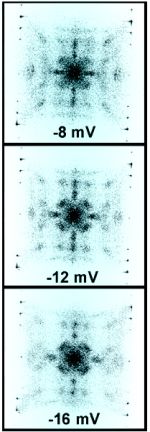
-
- Eightfold Quantum States
- http://en.wikipedia.org/wiki/Quark_model
-
Eightfold Way of the Universe
- Attribute 1. Particles, laws, and the universe are an inter-dependent trilogy
- Attribute 2. Dimensions are a property of an ensemble of matter.
- Attribute 3. Interacting particles must be aware of each other
- Attribute 4. The accessible universe is limited by communication
- Attribute 5. The Dimension of Time requires a cosmological clock
- Attribute 6. Space has properties
- Attribute 7. Mach's Principle
- Attribute 8. The properties of space appear to underlie the properties of matter and the laws of physics.
- The Octad Generator
- Solomon’s Cube
- Eight as 23
- Design and Psychology
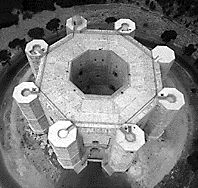
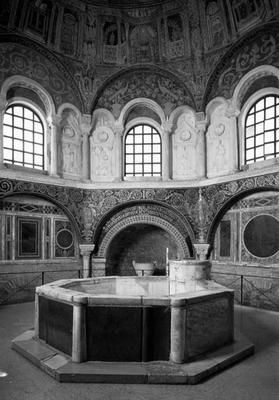
-
- Eight Design Matrix Functions
- Eight Patterns – TRIZ
- Eight Types Sensation
- Eight Team Roles
-
Eight Consulting Roles
- There are eight possible consulting roles
- 1. Providing information
- 2. Solving a specific problem
- 3. Diagnosis / problem redefinition
- 4. Recommendation based on diagnosis
- 5. Assist with implementation
- 6. Build consensus & commitment
- 7. Facilitate client learning
- 8. Permanently improve effectiveness
- The Eight Elements of TQM
- Log in to post comments
